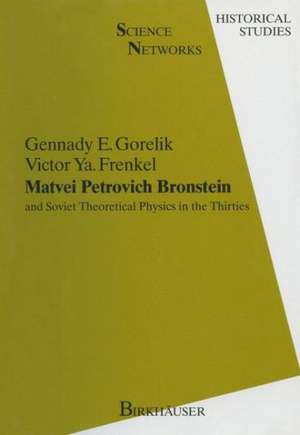Matvei Petrovich Bronstein and Soviet Theoretical Physics in the Thirties: and Soviet Theoretical Physics in the Thirties: Science Networks. Historical Studies, cartea 12
Autor Gennady E. Gorelik Traducere de V.M. Levina Autor Victor Ya. Frenkelen Limba Engleză Paperback – 21 oct 2012
Din seria Science Networks. Historical Studies
- 18%
 Preț: 796.31 lei
Preț: 796.31 lei - 15%
 Preț: 652.49 lei
Preț: 652.49 lei - 18%
 Preț: 787.15 lei
Preț: 787.15 lei -
 Preț: 489.30 lei
Preț: 489.30 lei - 15%
 Preț: 476.75 lei
Preț: 476.75 lei -
 Preț: 389.31 lei
Preț: 389.31 lei - 15%
 Preț: 699.59 lei
Preț: 699.59 lei - 15%
 Preț: 660.37 lei
Preț: 660.37 lei - 15%
 Preț: 531.59 lei
Preț: 531.59 lei - 24%
 Preț: 909.27 lei
Preț: 909.27 lei -
 Preț: 396.24 lei
Preț: 396.24 lei - 18%
 Preț: 903.17 lei
Preț: 903.17 lei -
 Preț: 382.36 lei
Preț: 382.36 lei -
 Preț: 395.25 lei
Preț: 395.25 lei - 15%
 Preț: 647.73 lei
Preț: 647.73 lei - 15%
 Preț: 702.87 lei
Preț: 702.87 lei - 15%
 Preț: 674.74 lei
Preț: 674.74 lei - 15%
 Preț: 655.60 lei
Preț: 655.60 lei - 15%
 Preț: 650.19 lei
Preț: 650.19 lei - 15%
 Preț: 644.82 lei
Preț: 644.82 lei - 15%
 Preț: 646.62 lei
Preț: 646.62 lei - 18%
 Preț: 1119.08 lei
Preț: 1119.08 lei - 18%
 Preț: 1135.46 lei
Preț: 1135.46 lei - 20%
 Preț: 595.48 lei
Preț: 595.48 lei - 20%
 Preț: 596.59 lei
Preț: 596.59 lei - 15%
 Preț: 649.06 lei
Preț: 649.06 lei - 20%
 Preț: 567.63 lei
Preț: 567.63 lei - 15%
 Preț: 639.37 lei
Preț: 639.37 lei -
 Preț: 399.12 lei
Preț: 399.12 lei - 18%
 Preț: 1390.11 lei
Preț: 1390.11 lei -
 Preț: 361.03 lei
Preț: 361.03 lei - 18%
 Preț: 1395.63 lei
Preț: 1395.63 lei - 15%
 Preț: 642.36 lei
Preț: 642.36 lei - 15%
 Preț: 648.24 lei
Preț: 648.24 lei - 15%
 Preț: 649.06 lei
Preț: 649.06 lei -
 Preț: 392.37 lei
Preț: 392.37 lei
Preț: 385.25 lei
Nou
Puncte Express: 578
Preț estimativ în valută:
73.73€ • 76.69$ • 60.87£
73.73€ • 76.69$ • 60.87£
Carte tipărită la comandă
Livrare economică 14-28 aprilie
Preluare comenzi: 021 569.72.76
Specificații
ISBN-13: 9783034896443
ISBN-10: 3034896441
Pagini: 212
Ilustrații: 208 p.
Dimensiuni: 170 x 244 x 11 mm
Greutate: 0.35 kg
Ediția:1994
Editura: Birkhäuser Basel
Colecția Birkhäuser
Seria Science Networks. Historical Studies
Locul publicării:Basel, Switzerland
ISBN-10: 3034896441
Pagini: 212
Ilustrații: 208 p.
Dimensiuni: 170 x 244 x 11 mm
Greutate: 0.35 kg
Ediția:1994
Editura: Birkhäuser Basel
Colecția Birkhäuser
Seria Science Networks. Historical Studies
Locul publicării:Basel, Switzerland
Public țintă
ResearchCuprins
1 Childhood and Youth. Road to Science.- 2 In the Leningrad University (1926–1932).- 2.1. Entering the University.- 2.2. The Jazz-Band.- 2.3. The Abbot and his Astronomer Friends.- 2.4. First Works in Astrophysics, Geophysics and Popular Science.- 2.5. At the Shenroks on the Vasiliev Island.- 3 At the Leningrad Physicotechnical Institute.- 3.1. Theoretical Physics in St. Petersburg and Petrograd.- 3.2. The Physicotechnical Institute and Its Seminars.- 3.3. “Quantising Free Electrons in a Magnetic Field”.- 3.4. “A New Crisis in the Theory of Quanta”.- 3.5. Science and Society.- 3.6. Quantum Mechanics in the Early Thirties.- 3.7. Cosmology in the Early Thirties.- 3.8. The Ether and the Theory of Relativity.- 3.9. Styles and Generations.- 3.10. The Physics of Semiconductors and Nuclear Physics.- 4 Hard Times for the Laws of Conservation and for Theoreticians.- 4.1. Three Attempts to Topple the Law of Conservation of Energy.- 4.2. The Hypothesis of Non-conservation and the Arguments of its Supporters.- 4.3. Non-Physical Arguments Applied to Physics.- 4.4. A Duel in Sorena.- 4.5. The Death of a Non-conservation Hypothesis.- 5 cG?-Physics in Bronstein’s Life.- 5.1. An Unsuitable Thesis.- 5.2. The Roots of Bronstein’s Interest in cG?-physics.- 5.3. The Quantum Theory of the Weak Gravitational Field.- 5.4. “The Fundamental Differences Between Quantum Electrodynamics and the Quantum Theory of Gravitational Field”. The Quantum Gravitational Limits.- 5.5. Physics and Cosmology.- 6 Creative Personality.- 6.1. Perceiving the World.- 6.2. Vocation of a Teacher.- 6.3. Science and Literature.- 6.4. Personality.- Afterword.- Afterword to the English Edition. Half a Century Later.- 1. From the KGB-NKVD Archives.- 2. The Last Days in the Cell.- 3. Subnuclear Physics,Matvei Bronstein and Ettore Majorana.- Chronology.- Notes.- Appendix 1. Extract from M.P.Bronstein’s paper “Quantentheorie schwacher Gravitationsfelder”, 1936.- Appendix 2. M.P.Bronstein’s note “Über den Spontanen Zerfall der Photonen”, 1936.- Appendix 3. M.P.Bronstein “Inventors of Radiotelegraph” (First chapters of the book).- Photographs.















